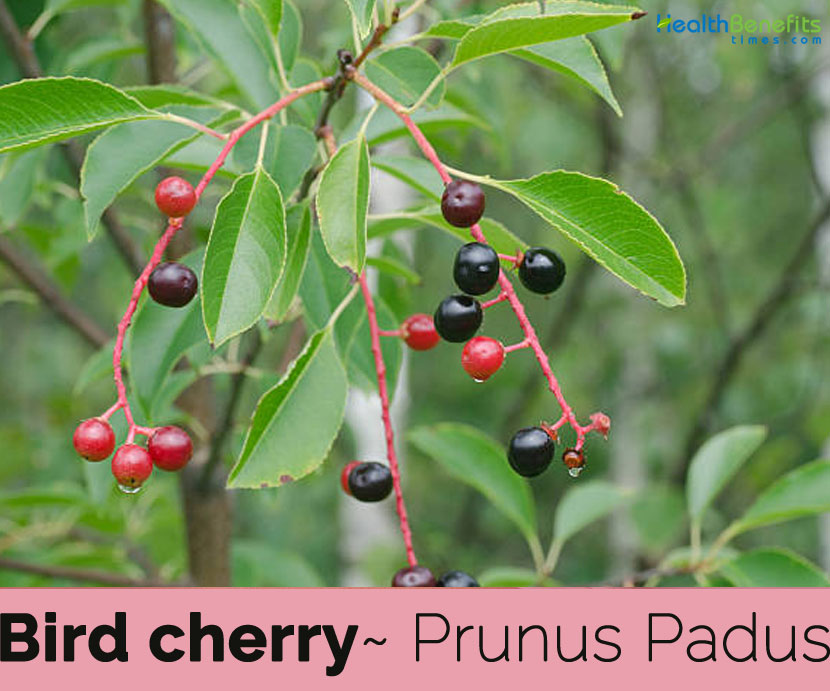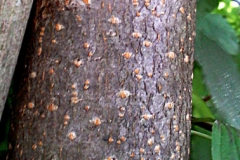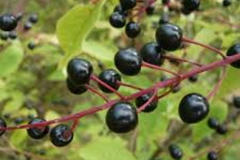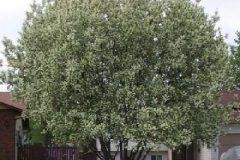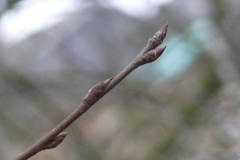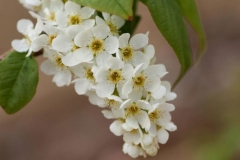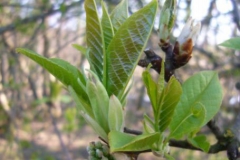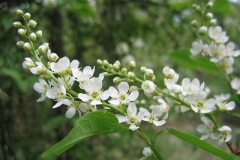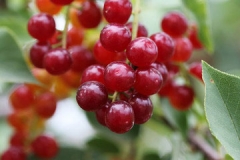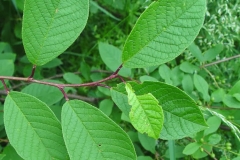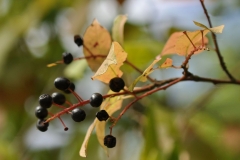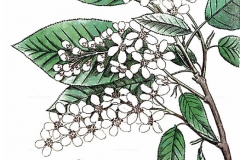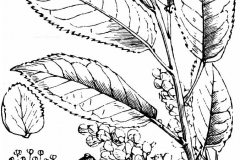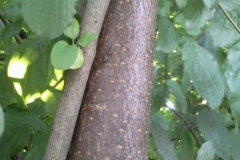Plant Description
Bird cherry is a deciduous small tree or large shrub that grows about 8- 16 m tall. The plant is found growing in streams and in moist open woods, usually on alkaline soils but also found on acid soils in upland areas, wet woodland, hedgerows, stream, river banks, broad leaf woods, waterside thickets, forest margins. The plant can succeed in any soil, favoring a well-drained moisture-retentive loamy soil. It also prefers some lime in the soil but is likely to become chlorotic if too much lime is present. Bark is grey to brown in color and feels smooth but peels with age and turns the surface rough. It also produces a funny smell, which is unpleasantly bitter. Twigs are dark brown in color but have light markings on them. Shoots have small hairs on them but fall off with age.
Leaves
Leaves are ovate to obovate, 50-100 mm long, 30-60 mm wide, acuminate, rounded or cordate at base, finely serrulate, dark green above, glabrous or with white hairs along lower side midrib, firm and leathery with sunken veins. Petioles are stout 0.8-2 mm in diameter, 10-20 mm long, grooved, red with two prominent dark red/brown extra floral nectaries, one on each side of the distal end. The leaves turn a beautiful red, then yellow before falling in the autumn.
Flowers
Flowers appear in large clusters of up to forty flowers on each pendulous raceme making a stunning spring display. The white flowers each have five petals, contain both male and female reproductive parts and have a strong almond scent. Flowering normally takes place from May and June. Pollination is carried out by bees and flies.
Fruit
Once the flowers have been pollinated by various insects they develop into a sub-globose or globose-ovoid, 6-8 mm long and about 5 mm wide drupe. This red fruit ripens through the summer and eventually turns into a dark purple-black due to the presence of anthocyanins. A fresh drupe weighs 130-210 mg. The texture of skin (exocarp) is shiny and glabrous. The edible outer layer (mesocarp) of fruits surrounds a stone (endocarp). The hard and globose stone contains one seed. The stony endocarp protects the seed physically.
Fruit although edible has a very bitter taste and contains a poisonous stone but birds such as the Robin, Redwing, Blackbird and Fieldfare, as the trees name suggests, love them, providing them with a valuable source of vitamin C and other minerals. The seed is not digested by the birds and is therefore distributed far and wide through their droppings. Apart from being an important food source for birds, many small mammals benefit from any of the fallen fruit.
Varieties
There are two varieties:
- European bird cherry Prunus padus var. padus, Europe and western Asia
- Asian bird cherry Prunus padus var. commutata, eastern Asia
- In small quantities, hydrogen cyanide has been shown to stimulate respiration and improve digestion, it is also claimed to be of benefit in the treatment of cancer.
- Bark is mildly anodyne, diuretic, febrifuge and sedative.
- An infusion is used in the treatment of colds, feverish conditions etc.
- Bark is harvested when the tree is in flower and can be dried for later use.
- In the past the bird cherry has been used to treat both kidney and gall stones and when dissolved with wine, for the treatment of coughs.
- Bird cherry has also been used as eyewash for conjunctivitis, and to treat angina, bronchitis, anemia and various inflammatory diseases.
Culinary Uses
- Fruit can be consumed raw or cooked.
- Fruit usually has a bitter taste and is used mainly for making jam and preserves. Flowers can be chewed.
- Young leaves can be consumed after being cooked.
- Young leaves can be used as a boiled vegetable in Korea. Seed can be consumed raw or cooked.
- Tea is made from the bark.
- At one time berries were used for flavoring some alcoholic drinks.
Other Facts
- Green dye can be obtained from the leaves.
- Dark grey to green dye can be obtained from the fruit.
- Wood is hard, heavy, durable, easy to work, polishes well.
- Wood is much valued by cabinet makers, wooden boxes, tool handles, and cask hoops and for carving.
- Bark of the tree, placed at the door, was supposed to ward off plague.
- Bark produces a reddish brown dye and is used for dyeing fishing nets.
- At one time the people of Scotland thought it was a witch’s tree and there were warnings not to use the tree for any purpose.
- Foliage is toxic to all livestock but in particular to goats.
- Due to the barks very unpleasant odor, it is said that the placing of bird cherry twigs in barns and other outbuildings can keep rodents at bay.
- The sickly almond scented flowers attract many insects, particularly bees and flies.
Precautions
- Seed and leaves consist of hydrogen cyanide, a poison that gives almonds their characteristic flavor.
- This toxin is readily detected by its bitter taste. Usually bitter seed or fruit should not be eaten.
- In excess, however, it can cause respiratory failure and even death.
- The glycosides prulaurasin and amygdalin, which can be poisonous to some mammals, are present in some parts of P. padus, including the leaves, stems and fruits.
References:
https://www.itis.gov/servlet/SingleRpt/SingleRpt?search_topic=TSN&search_value=24798#null
https://davesgarden.com/guides/pf/go/31446/
https://npgsweb.ars-grin.gov/gringlobal/taxonomydetail.aspx?id=30057
https://pfaf.org/user/Plant.aspx?LatinName=Prunus+padus
http://www.missouribotanicalgarden.org/PlantFinder/PlantFinderDetails.aspx?kempercode=g980\
https://plants.usda.gov/core/profile?symbol=prpa5
https://www.iucnredlist.org/species/172090/61616618
http://www.theplantlist.org/tpl1.1/record/rjp-45
https://en.wikipedia.org/wiki/Prunus_padus
https://gd.eppo.int/taxon/PRNPA
Comments
| Bird cherry Quick Facts | |
|---|---|
| Name: | Bird cherry |
| Scientific Name: | Prunus Padus |
| Origin | Europe and northern Asia, and has also been reported from Morocco in North Africa |
| Colors | Red fruit which ripens eventually into a dark purple-black |
| Shapes | small drupe cherries roughly the size of a pea, with a large seed |
| Taste | Very bitter |
| Health benefits | Beneficial for colds, feverish conditions, kidney and gall stones, conjunctivitis, angina, bronchitis, anemia and various inflammatory diseases |
| Name | Bird cherry |
|---|---|
| Scientific Name | Prunus Padus |
| Native | Europe and northern Asia, and has also been reported from Morocco in North Africa |
| Common Names | European bird-cherry, Bird-cherry, Hackberry, Hog berry, Cerezo aliso, hagberry, Mayday tree |
| Name in Other Languages | Armenian: T’kheni (Թխենի) Azerbaijani: Adi meşəgilası Bashkir: Муйыл Basque: Otsagereziondo, txerri-gerezitzea Belarusian: Čaromcha zvyčajnaja (Чаромха звычайная) Bulgarian: pesŭkinya (песъкиня), grozdovidna pesŭkinya (гроздовидна песъкиня) Catalan: Gatzerí, cirer bort, cirerer bord Chechen: Черемшина Chinese: Chou li Chuvash: Çĕмĕрт Croatian: Sremza Czech: Střemcha obecná Danish: Haeg, Majtrae, Almindelig hæg Dutch: Vogelkers, Gewone vogelkers, vogelkerseboom English: European bird-cherry, Bird-cherry, Hackberry, Hog berry, Cerezo aliso, hagberry Estonian: Harilik toomingas Finnish: Tuomi French: Cerisier à grappes, Merisier à grappes, Cerisier à grappes d’Europe, bois puant, cerisier putiet, faux bois de Sainte Lucie, putier Galician: Cerdeira Georgian: Shotkhvi (შოთხვი) German: Ahlkirsche, Else, Echte Traubenkirsche, Faulbeerbaum, Gemeine Traubenkirsche, Stinkbeere, Sumpfkirsche, Traubenkirsche, Gewöhnliche Traubenkirsche, Auentraubenkirschbaum, Auentraubenkirsche, Elsen, Faulbaum, gewöhnlicher Traubenkirschbaum, Kirschbaum, Traubenkirschbaum Hindi: Jaamanaa Hungarian: Zelnicemeggy, májusfa Icelandic: Heggur Italian: Ciliegio a grappoli, Visciolo a grappoli, Ciliegio pado, Ciliegiola grappoli, Pado Irish: Donnroisc Japanese: Eso no uwa mizu zakura, Ezo no uwa mizu zakura (エゾノウワミズザクラ) Kazakh: Şomırt (Шомырт) Komi: Льӧм Korean: Gui rung na mu, gwirungnamu Latvian: Parastā ieva Lithuanian: Paprastoji ieva Manx: Billey shillish figgagh Northern Sami: Ávža Norwegian: Hegg Ossetian: Тæфхъæд Persian: گیلاس پرنده Polish: Czeremcha pospolita, czeremcha zwyczajna Portuguese: Azereiro-dos-danados, Pado, cerejeira-de-mahoma, Romanian: Mălin Russian: Cheremukha, Cheremukha obyknovennaia, Cheromukha obyknovennaya (Черёмуха обыкновенная) Serbian: Сремза Slovak: Cremcha obyčajná Slovenian: Chremsa, Čremza Spanish: Cerezo aliso, cerezo de racimo, cerezo de San Gregorio, cerezo silvestre , ciruelo de Bahama, palo de la rabia, palo de San Gregorio, árbol de la rabia Swedish: Hagg, Tuomi, häggträd Tatar: Шомырт Turkish: Açık köklü, kuş kirazı Ukrainian: Cheremkha zvychayna (Черемха звичайна) Uzbek: Cheremuxa Welsh: Coeden Geirios yr Adar |
| Plant Growth Habit | Deciduous small tree or large shrub |
| Growing Climates | Streams and in moist open woods, usually on alkaline soils but also found on acid soils in upland areas, wet woodland, hedgerows, stream, river banks, Broadleaf woods, waterside thickets, forest margins |
| Soil | Succeeds in any soil, preferring a well-drained moisture-retentive loamy soil. Prefers some lime in the soil but is likely to become chlorotic if too much lime is present |
| Plant Size | About 8- 16 m tall |
| Bark | Grey to brown in color and feels smooth but peels with age and turns the surface rough; it also produces a funny smell, which is unpleasantly bitter |
| Twigs | Dark brown in color but have light markings on them; shoots have small hairs on them but fall off with age |
| Leaf | Ovate to obovate, 50-100 mm long, 30-60 mm wide, acuminate, rounded or cordate at base, finely serrulate, dark green above, glabrous or with white hairs along lower side midrib, firm and leathery with sunken veins |
| Flowering season | May and June |
| Pollination | By bees and flies |
| Flower | Flowers appear in large clusters of up to forty flowers on each pendulous raceme making a stunning spring display. The white flowers each have five petals, contain both male and female reproductive parts and have a strong almond scent |
| Fruit Shape & Size | Small drupe Cherries roughly the size of a pea, with a large seed |
| Fruit Color | Red fruit which ripens eventually into a dark purple-black |
| Propagation | By seeds, grafting or budding |
| Taste | Very bitter taste |
| Plant Parts Used | Bark |
| Season | July to August |


